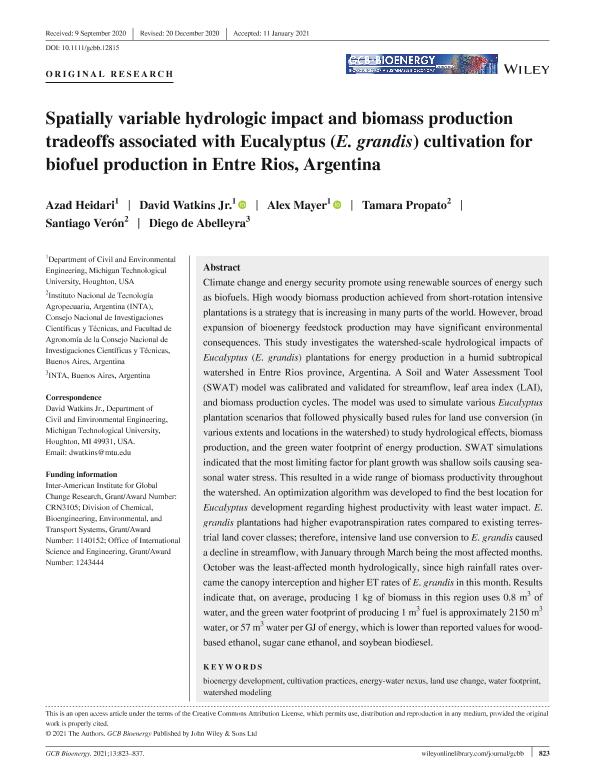Artículo
Spatially variable hydrologic impact and biomass production tradeoffs associated with Eucalyptus (E. grandis) cultivation for biofuel production in Entre Rios, Argentina
Heidari, Azad; Watkins, David; Mayer, Alex; Propato, Tamara Sofía ; Verón, Santiago Ramón
; Verón, Santiago Ramón ; de Abelleyra, Diego
; de Abelleyra, Diego
 ; Verón, Santiago Ramón
; Verón, Santiago Ramón ; de Abelleyra, Diego
; de Abelleyra, Diego
Fecha de publicación:
05/2021
Editorial:
Blackwell Publishing
Revista:
GCB Bioenergy
ISSN:
1757-1693
e-ISSN:
1757-1707
Idioma:
Inglés
Tipo de recurso:
Artículo publicado
Clasificación temática:
Resumen
Climate change and energy security promote using renewable sources of energy such as biofuels. High woody biomass production achieved from short-rotation intensive plantations is a strategy that is increasing in many parts of the world. However, broad expansion of bioenergy feedstock production may have significant environmental consequences. This study investigates the watershed-scale hydrological impacts of Eucalyptus (E. grandis) plantations for energy production in a humid subtropical watershed in Entre Rios province, Argentina. A Soil and Water Assessment Tool (SWAT) model was calibrated and validated for streamflow, leaf area index (LAI), and biomass production cycles. The model was used to simulate various Eucalyptus plantation scenarios that followed physically based rules for land use conversion (in various extents and locations in the watershed) to study hydrological effects, biomass production, and the green water footprint of energy production. SWAT simulations indicated that the most limiting factor for plant growth was shallow soils causing seasonal water stress. This resulted in a wide range of biomass productivity throughout the watershed. An optimization algorithm was developed to find the best location for Eucalyptus development regarding highest productivity with least water impact. E. grandis plantations had higher evapotranspiration rates compared to existing terrestrial land cover classes; therefore, intensive land use conversion to E. grandis caused a decline in streamflow, with January through March being the most affected months. October was the least-affected month hydrologically, since high rainfall rates overcame the canopy interception and higher ET rates of E. grandis in this month. Results indicate that, on average, producing 1 kg of biomass in this region uses 0.8 m3 of water, and the green water footprint of producing 1 m3 fuel is approximately 2150 m3 water, or 57 m3 water per GJ of energy, which is lower than reported values for wood-based ethanol, sugar cane ethanol, and soybean biodiesel.
Archivos asociados
Licencia
Identificadores
Colecciones
Articulos(SEDE CENTRAL)
Articulos de SEDE CENTRAL
Articulos de SEDE CENTRAL
Citación
Heidari, Azad; Watkins, David; Mayer, Alex; Propato, Tamara Sofía; Verón, Santiago Ramón; et al.; Spatially variable hydrologic impact and biomass production tradeoffs associated with Eucalyptus (E. grandis) cultivation for biofuel production in Entre Rios, Argentina; Blackwell Publishing; GCB Bioenergy; 13; 5; 5-2021; 823-837
Compartir
Altmétricas



